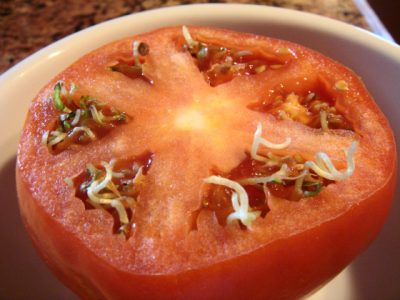By Amelia Martin, UConn Plant Science Graduate Student

You may have noticed the heavy rains and chilly temperatures last week’s nor ’easter brought to Connecticut. Maybe you were one of many who checked their back window to see their gardens had flooded and their plants are looking worse for the wear. If this sounds familiar and you are curious what garden flooding means for your plants and want to know how to protect them- you found the right article!
A flooded garden is not a unique problem, especially during periods of heavy rainfall, but there are some factors that may contribute to the severity of flooding. Having minimal or poor drainage can amplify the problem, especially if planting in garden boxes with closed bottoms. Soil compaction can contribute to flooding if you are planting directly in the ground. Compacted soil can happen if there has been too much tillage, if wheels or machinery have been over the area, or even from excess foot traffic. Lastly, the layout and landscaping of a yard can contribute to flooding as well. If you placed your garden at the bottom of a hill or there are minimal drainage angles surrounding your garden, water may be pooling up faster than it can drain.
To prevent flooding, check your gutters and make sure they are free from debris and directed to a drain or storm barrel. Put down gravel and mulch to help prevent surface flooding. Avoid cutting your grass too short to maintain strong roots which help to absorb water. Maintain healthy soil to allow for the best water absorption. Dig out a shallow drainage channel if you have the space for it. Consider switching to raised beds with drainage rather than in-ground gardens in easily flooded areas. Try adding native plants to your garden. Native plants have deep roots which helps them absorb excess water and prevent runoff. While handling these issues would be preventative measures, let’s talk about what to do if your garden has already flooded.
Assess the drainage situation and take note of where the water is pooling the most. If flooding is unusual in your garden- there may be something blocking the normal drainage route, which may be a quick fix. If not, knowing where water is likely to pool may help in future garden planning, or help you determine where to make improvements.
Stay off your garden beds. If you step on your soil while it is saturated, it will compact it, ruining the soil’s tilth. Instead, if you need to access your garden beds consider putting a wooden board down to walk on to distribute your weight better.
Re-fertilize your plants. Heavy rain can wash away nutrients out of the soil through a process called leaching. Check the forecast to make sure no more extreme weather is immediately approaching before fertilizing- or you may have to do it again.
Add supports to your plants. The wind and rain may have led to plants falling over. Add in some additional supports to get them upright again and give them a better chance for the next time heavy rain comes.
While having a flooded garden may be a bummer, there are some gardening activities that are actually easier to do in saturated soil! Once the rain stops and the ground is still wet, use this time to weed. The soft ground will make weeds especially easy to pull up- just try not to step on the garden beds. After a rain or a flood, re-mulching is always a good idea. The rain might wash away some previously placed mulch, use this as an opportunity to locate any spots barren of mulch and in need of a re-fill. After a couple days when the soil is soft but not sodden, the ground will be the perfect consistency to dig and put stakes.
Lastly, check for any young plants that didn’t survive the water or any seeds that haven’t come up. Take this as an opportunity to plant new seeds, as seeds do better in already moist soil where they have less chance of being displaced when watered.
At the end of the day, while having a flooded garden may not be the best for your plants, it is not the end of the world. There are a handful of preventative measures that can be taken ranging from backyard renovations to quick fixes- it is about finding what works best for you and your garden.
The UConn Home & Garden Education Center supports UConn Extension’s mission by providing answers you can trust with research-based information and resources. For gardening questions, contact us toll-free at (877) 486-6271, visit our website at homegarden.cahnr.uconn.edu, or reach out to your local UConn Extension center at cahnr.uconn.edu/extension/locations.
This article was published in the Hartford Courant May 31, 2025
